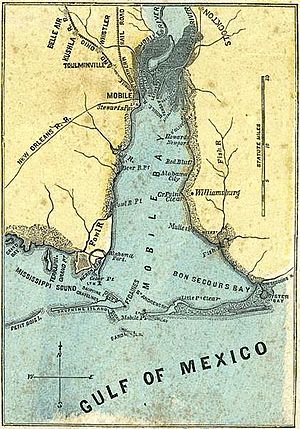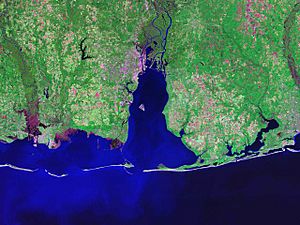Mobile Bay facts for kids
Mobile Bay is a shallow bay connected to the Gulf of Mexico. It is located in the state of Alabama in the United States. The bay's entrance is guarded by the Fort Morgan Peninsula on the east and Dauphin Island, a natural barrier island, on the west. The Mobile River and Tensaw River flow into the northern part of the bay, making it an estuary. An estuary is where fresh river water mixes with salty ocean water. Other smaller rivers like Dog River, Deer River, Fowl River, and Fish River also feed into the bay. Mobile Bay is one of the largest estuaries in the United States. Every year, especially in summer, fish and crabs gather near the bay's shallow shores. This amazing event is called a jubilee, and it's a popular time for people to easily catch fresh seafood.
Mobile Bay covers about 413 square miles (1,070 square kilometers). It is 31 miles (50 km) long and up to 24 miles (39 km) wide. While the deepest parts of the bay, like the shipping channel, can be over 75 feet (23 meters) deep, the bay's average depth is around 10 feet (3 meters).
Contents
Exploring Mobile Bay's Past
Long ago, Native American groups lived around Mobile Bay. When Hernando de Soto explored the area, these groups were part of the Mississippian culture.
The written history of Mobile Bay began around 1500. This is when Spanish explorers first sailed into the area. On old maps, the bay was called Bahía del Espíritu Santo, which means "Bay of the Holy Spirit." Explorers like Diego Miruelo in 1516 and Alonso Álvarez de Pineda in 1519 explored the bay more closely. In 1528, Pánfilo de Narváez likely traveled through this area. He met Native Americans who ran away and burned their towns as his group approached. This happened before Hernando de Soto's journeys, which took place more than eleven years later.
Early European Visits

Hernando de Soto explored the Mobile Bay area in 1540. He found that Mississippian culture people lived there. During his trip, his forces destroyed a fortified town called Mauvila. The name "Mobile" later came from this town. Mauvila was located inland in Alabama, far north of where the city of Mobile is today. The next big expedition was led by Tristán de Luna y Arellano in 1559. He tried to start a permanent Spanish colony nearby at Pensacola, but he was not successful.
Even though Spain had only a small presence in the area, French colonists arrived in 1702. They built a deep-sea port at Dauphin Island. They also founded the capital of French Louisiana at Mobile. This first settlement, called Fort Louis de la Mobile, was a few miles north of Mobile Bay on the Mobile River. After some floods, the settlement was moved in 1711 to the top of Mobile Bay.
Mobile Bay's Role in Wars
During the American Civil War, Mobile Bay was a very important port. Ships called blockade runners used it to bring supplies to the Confederacy. On August 5, 1864, Admiral David Farragut led a Union fleet. They sailed through Confederate defenses. This battle, known as the Battle of Mobile Bay, closed off one of the last major Southern ports. Many Civil War shipwrecks are still in Mobile Bay today. These include the American Diver, CSS Gaines, CSS Huntsville, USS Philippi, CSS Phoenix, USS Rodolph, USS Tecumseh, and CSS Tuscaloosa.
Mobile has continued to be an important seaport. The types of goods shipped have changed over time. In the 1800s, Cotton was the main product. During World War II, Mobile's shipbuilding industry grew a lot. Many people moved to the city for work, and its population increased quickly. The city has continued to grow rapidly since then.
Natural Disasters Affecting the Bay
The city of Mobile has faced several strong hurricanes. Some of the most recent were Hurricane Frederic in 1979 and Hurricane Katrina in 2005. Areas that are low, like the downtown business district, have been flooded many times by hurricanes. However, much of the city is high above sea level, which is unusual for coastal areas.
On September 13, 1979, Hurricane Frederic hit the bay with winds up to 145 miles per hour (233 km/h). It destroyed the bridge to Dauphin Island. On August 28–29, 2005, Hurricane Katrina pushed a huge storm surge into Mobile Bay. The water rose 16 feet (4.9 meters) high at Bayou La Batre and 12 feet (3.7 meters) high at Mobile. Thousands of boats, piers, and beach houses were damaged by waves over 22 feet (6.7 meters) high. The battleship USS Alabama was pushed off its moorings and tilted to one side. Downtown Mobile was flooded by several feet of water. The towns of Bayou La Batre and Bon Secour were badly damaged. Many boats of different sizes were left stranded inland.
Towns Along Mobile Bay
The city of Mobile is located at the northern end of the bay on the western side. On the Eastern Shore of the bay, you can find several smaller towns. These include Spanish Fort, Daphne, Fairhope, Point Clear, and Bon Secour. The town of Gulf Shores is just outside the bay, on the Fort Morgan peninsula. The town of Fort Morgan is directly south of the bay. The Middle Bay Lighthouse has stood in the center of the bay since 1885.
Two main roads cross the northern part of the bay. These are Interstate 10, also known as the Jubilee Parkway, and US 90/US 98, called the Battleship Parkway. These two bridges are the main ways to travel between the city of Mobile and the Eastern Shore. On warm summer nights, people living around Mobile Bay sometimes experience a mysterious natural event called a Jubilee. During a Jubilee, fish and crabs swim toward the shore. People can easily collect them by wading in the shallow water.
See also
 In Spanish: Bahía de Mobile para niños
In Spanish: Bahía de Mobile para niños


